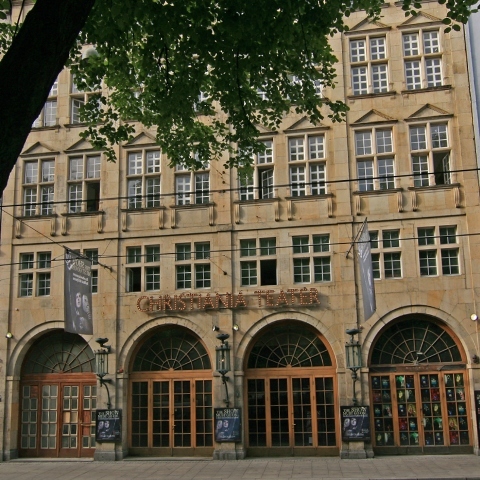Composers / Arne Nordheim / Places catalog
Norwegian Theatre I
The Norwegian Theatre was established in 1912, through the efforts of the writers and social activists Hulda and Arne Garborg. It was the result of linguist Ivar Aasen’s struggle to popularise the Neo-Norwegian language (Nynorsk), which he based on Norwegian dialects and the Old Norse language. Nynorsk was intended as an alternative to the language used by officialdom and the upper social classes “in the capital”, which was actually Danish with a slight Norwegian tinge. Still today, the theatre is owned by a joint-stock company, and it is the only institution of such importance in Norway not owned by the state or local government. The Theatre’s articles of association include a duty to present plays in Nynorsk and in dialects. Initially, it was a travelling theatre; only in the autumn of 1913 did it start performing in Oslo. The stage on which the “peasant language” was presented met with fierce opposition from the circles supporting the idea of an evolutionary departure from Danish. The Norwegian Theatre’s first shows broke European records for the length of booing and often ended with police interventions and arrests. The theatre was provocative not only in terms of the language, but also with its repertoire, staging controversial plays or classical works “translated” into Nynorsk (e.g. Ibsen’s Peer Gynt).
The Theatre was first located in the Peasant House (Bøndenes Hus), the newly built headquarters of its biggest shareholder, the Peasant Youth Association (Bondeungdomslag), at 8 Rosenkrantz’ gate. After the war, the Theatre moved to 16 Stortingsgata. This address is heavily laden with history. Before a lavish tenement house in Scandinavian Neo-Renaissance style was built here (1918), it was the home of the Cordial restaurant. In 1891, Edvard Grieg celebrated here the twenty-fifth anniversary of his pianistic debut in Christiania, accepting homage from his followers from a second-floor window. The new building, designed by Henry Coll, was erected for the “Opera Comique”. In 1921, it was taken over by the “Casino Theatre”, an operetta-cum-revue. Between 1921 and the German invasion of Norway in 1940, it hosted film projections. In 1941, the venue was refurbished (including a separate loge for the Reichskommisar Josef Terboven), and the “Deutsches Theater”, boycotted by the public, was organised there. After the war, until 1985, the theatre space was rented by the Norwegian Theatre.
On 17 October 1966, the Theatre premiered Shakespeare’s Othello in a Nynorsk translation by Ragnvald Skrede, with music by Arne Nordheim. The main protagonist was played by the American actor Earle Hyman. Today, the stage at Stortingsgata is used by the Christiana Theatre for musical performances.
-

Stortingsgata 16. Phot. Mahlum. (creative commons)